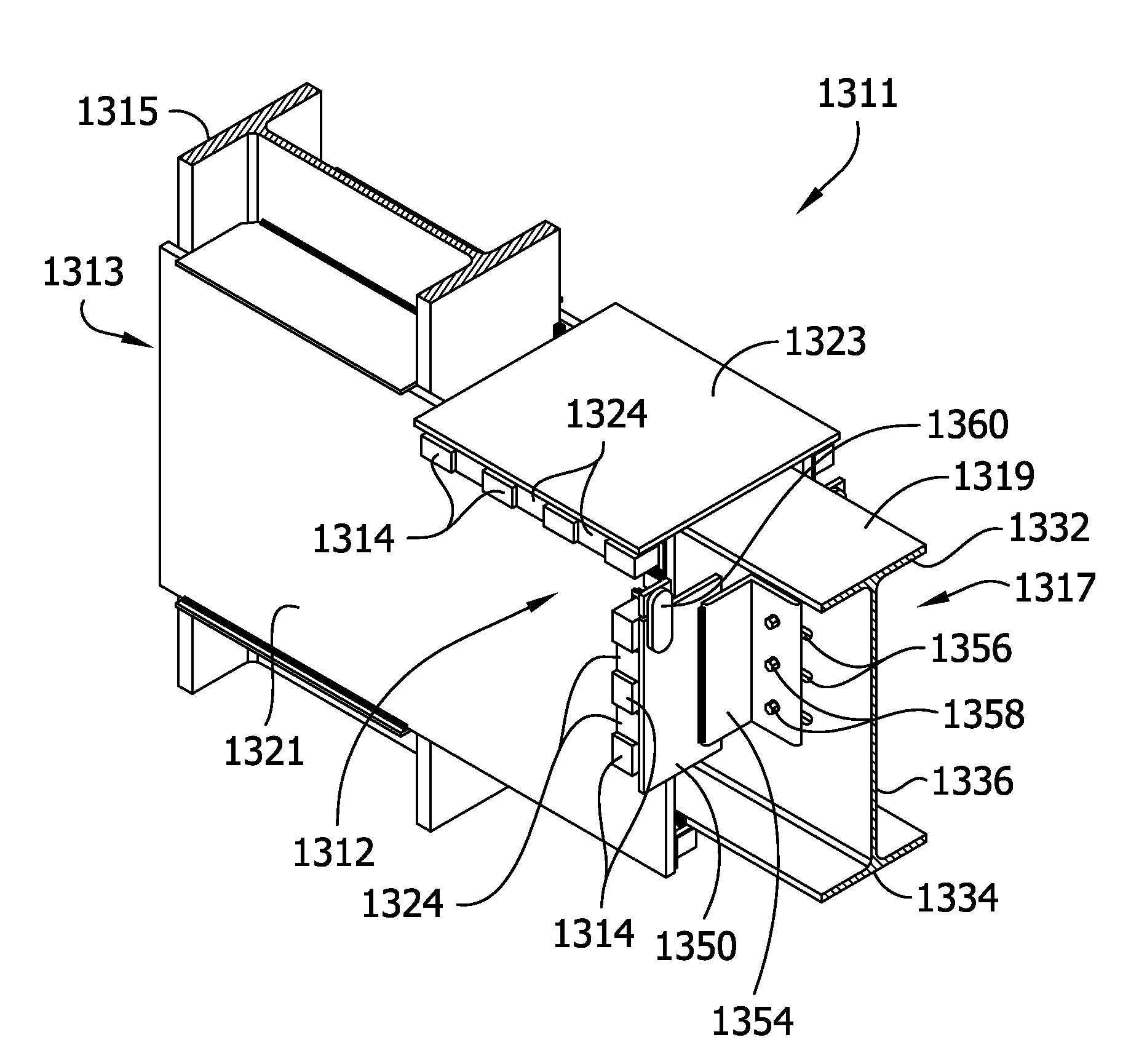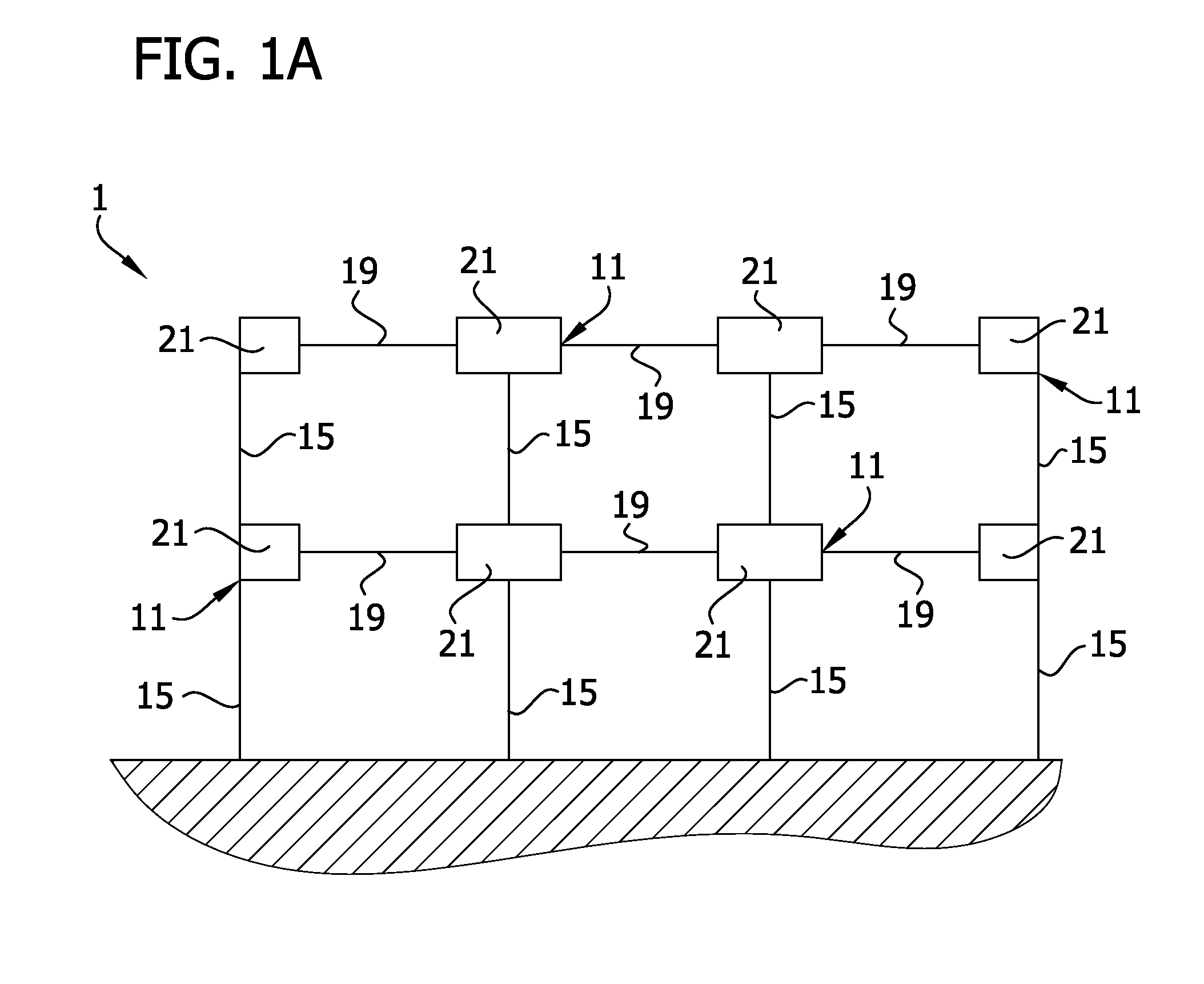Gusset plate connection in bearing of beam to column
a technology of gusset plate and beam, which is applied in the direction of structural elements, shock-proofing, building components, etc., can solve the problems of fractured welds, cracks in the column flange and column web, and uncertain practice of welding the beam's flanges directly to the column
- Summary
- Abstract
- Description
- Claims
- Application Information
AI Technical Summary
Benefits of technology
Problems solved by technology
Method used
Image
Examples
first embodiment
[0194]Referring to FIGS. 1-12, a beam-to-column moment-resisting joint connection structure of a first embodiment is generally indicated at 11. The joint connection structure may be used in the construction of a building framework F (see FIG. 1A). In the illustrated embodiment, the joint connection joins a column assembly 13 including a column 15 to a full-length beam assembly 17 including a full-length beam 19. A full-length beam is a beam that has a length sufficient to extend substantially the full-length between adjacent columns in a structure. Thus, a stub and link beam assembly as shown in FIGS. 5 and 16 of U.S. Pat. No. 6,138,427, herein incorporated by reference, is not a full-length beam. It is understood that the joint connection structure may be a beam-to-column type as shown, or a beam-to-column-to beam type as shown in U.S. Pat. No. 8,146,322, herein incorporated by reference, depending upon the location of the joint connection structure within a building's framework.
[0...
fifth embodiment
[0216]Referring to FIGS. 49-60, a beam-to-column moment-resisting joint connection structure of a fifth embodiment is generally indicated at 411. The joint connection structure may be used in the construction of a building framework. In the illustrated embodiment, the joint connection joins a column assembly 413 including a column 415 to a full-length beam assembly 417 including a full-length beam 419.
[0217]A spaced apart pair of parallel, vertically and horizontally extending gusset plates 421 sandwich the column 415 and beam 419. Four horizontal shear plates 423 (only three are shown in FIG. 49) are arranged in vertically spaced pairs generally aligned at top and bottom edges of the gusset plates 421. Two angle irons (broadly, “connecting members”) 425A are disposed on an upper flange of the beam 419 at an end of the beam. The angle irons 425A are horizontally spaced from one another and extend along a length of the beam 419. The angle irons 425A connect the gusset plates 421 to t...
sixth embodiment
[0224]Referring to FIGS. 61-72, a beam-to-column moment-resisting joint connection structure of a sixth embodiment is generally indicated at 511. The joint connection structure may be used in the construction of a building framework. In the illustrated embodiment, the joint connection structure 511 joins a column assembly 513 including a column 515 to a full-length beam assembly 517 including a full-length beam 519.
[0225]A spaced apart pair of parallel, vertically and horizontally extending gusset plates 521 sandwich the column 515 and end of beam 519. Four optional horizontal shear plates 523 (only three are shown in FIG. 61) are arranged in vertically spaced pairs generally aligned at top and bottom edges of the gusset plates 521. Two angle irons (broadly, “connecting members”) 525 are disposed on an upper flange of the beam 519 at an end of the beam. The angle irons 525 are horizontally spaced from one another and extend along a length of the beam 519. The angle irons 525 connect...
PUM
 Login to View More
Login to View More Abstract
Description
Claims
Application Information
 Login to View More
Login to View More - R&D
- Intellectual Property
- Life Sciences
- Materials
- Tech Scout
- Unparalleled Data Quality
- Higher Quality Content
- 60% Fewer Hallucinations
Browse by: Latest US Patents, China's latest patents, Technical Efficacy Thesaurus, Application Domain, Technology Topic, Popular Technical Reports.
© 2025 PatSnap. All rights reserved.Legal|Privacy policy|Modern Slavery Act Transparency Statement|Sitemap|About US| Contact US: help@patsnap.com



